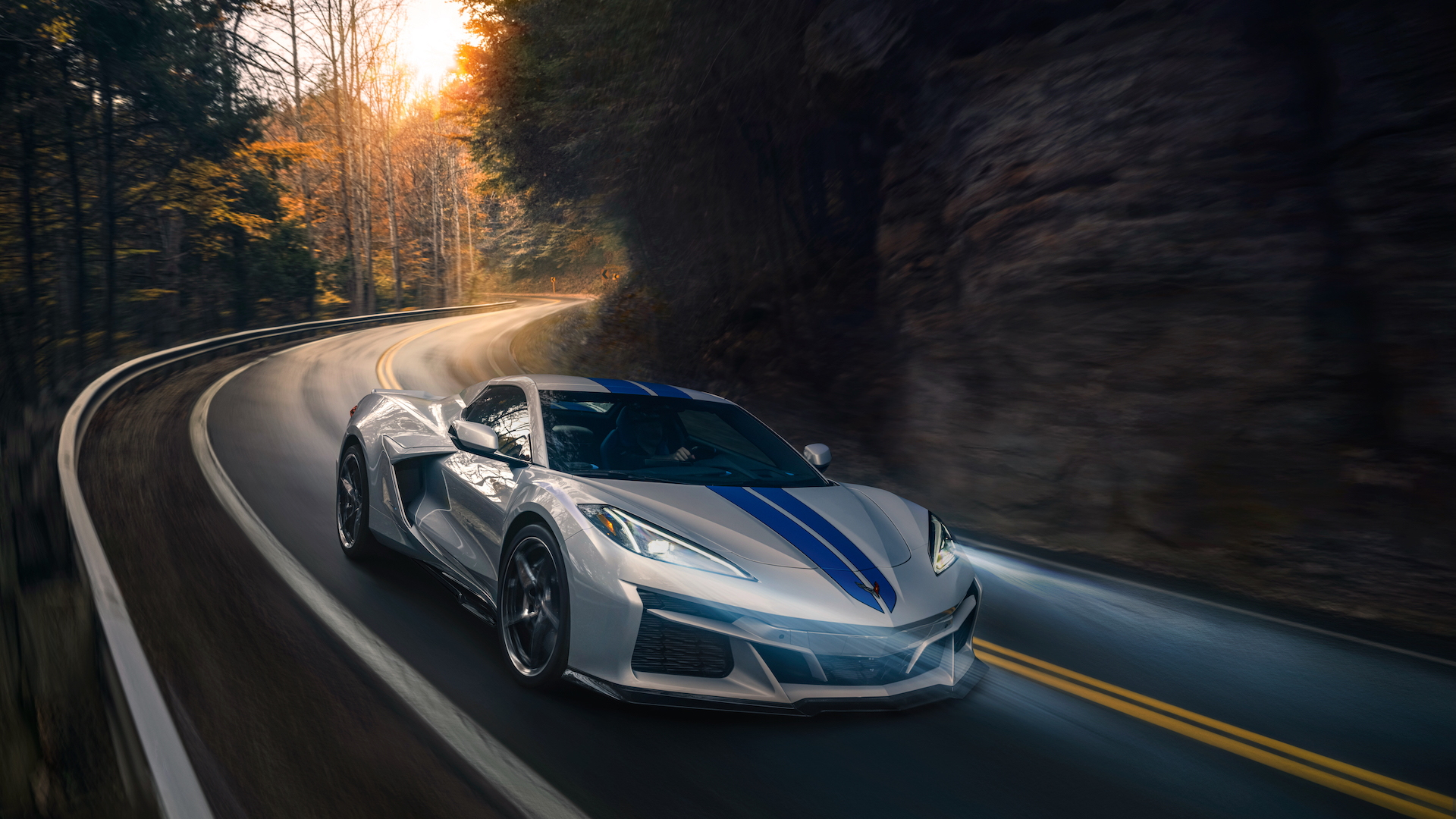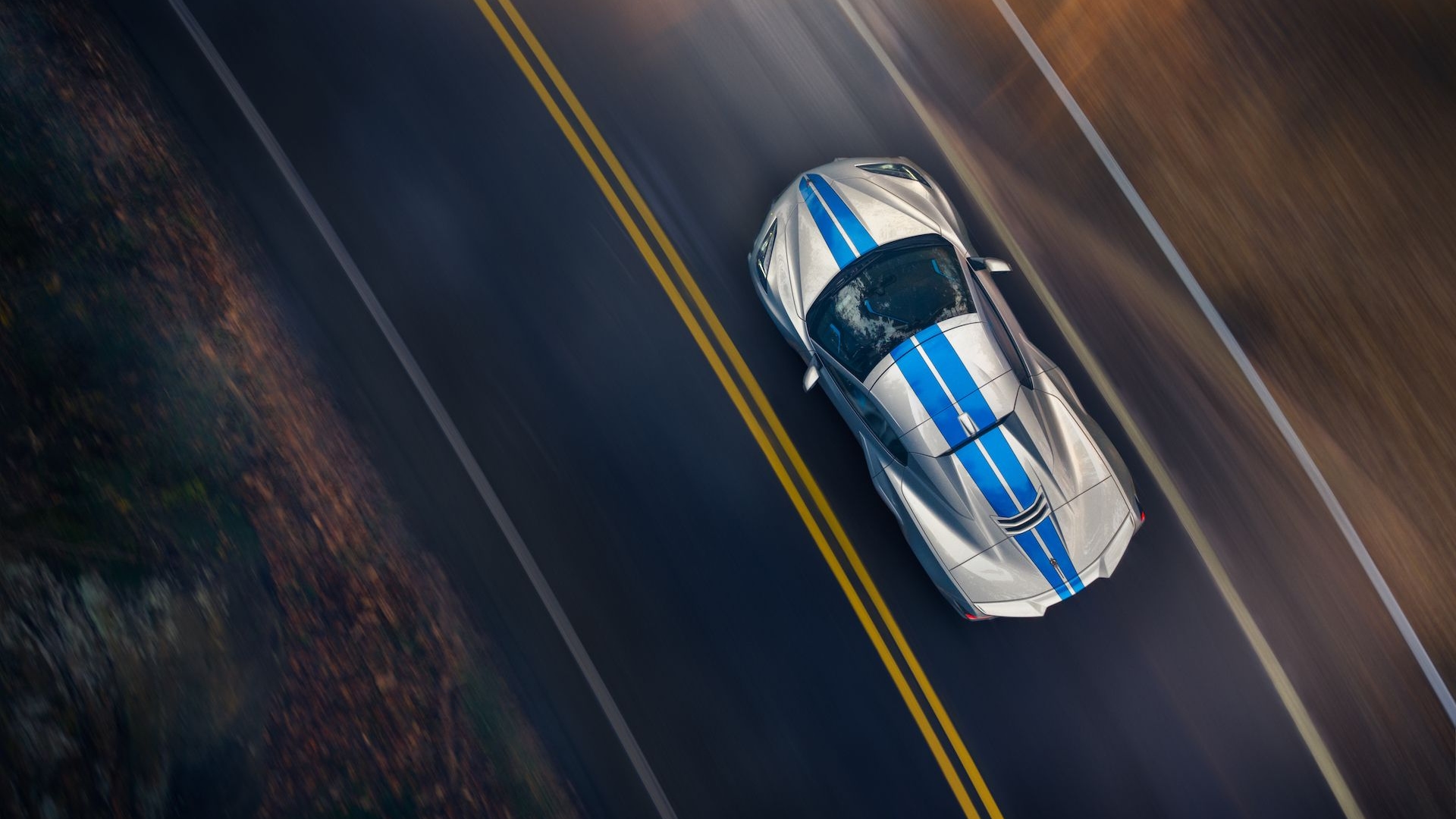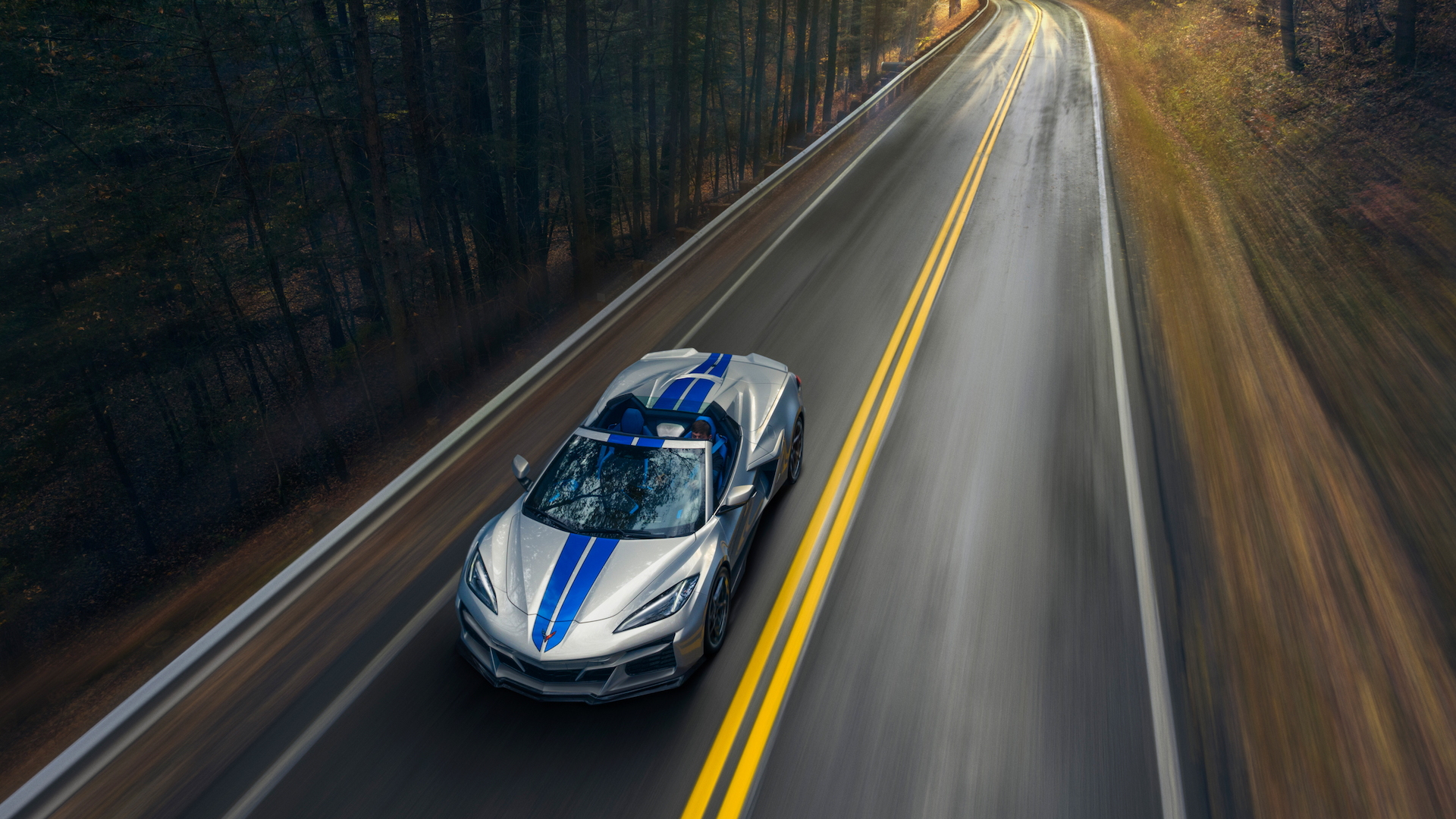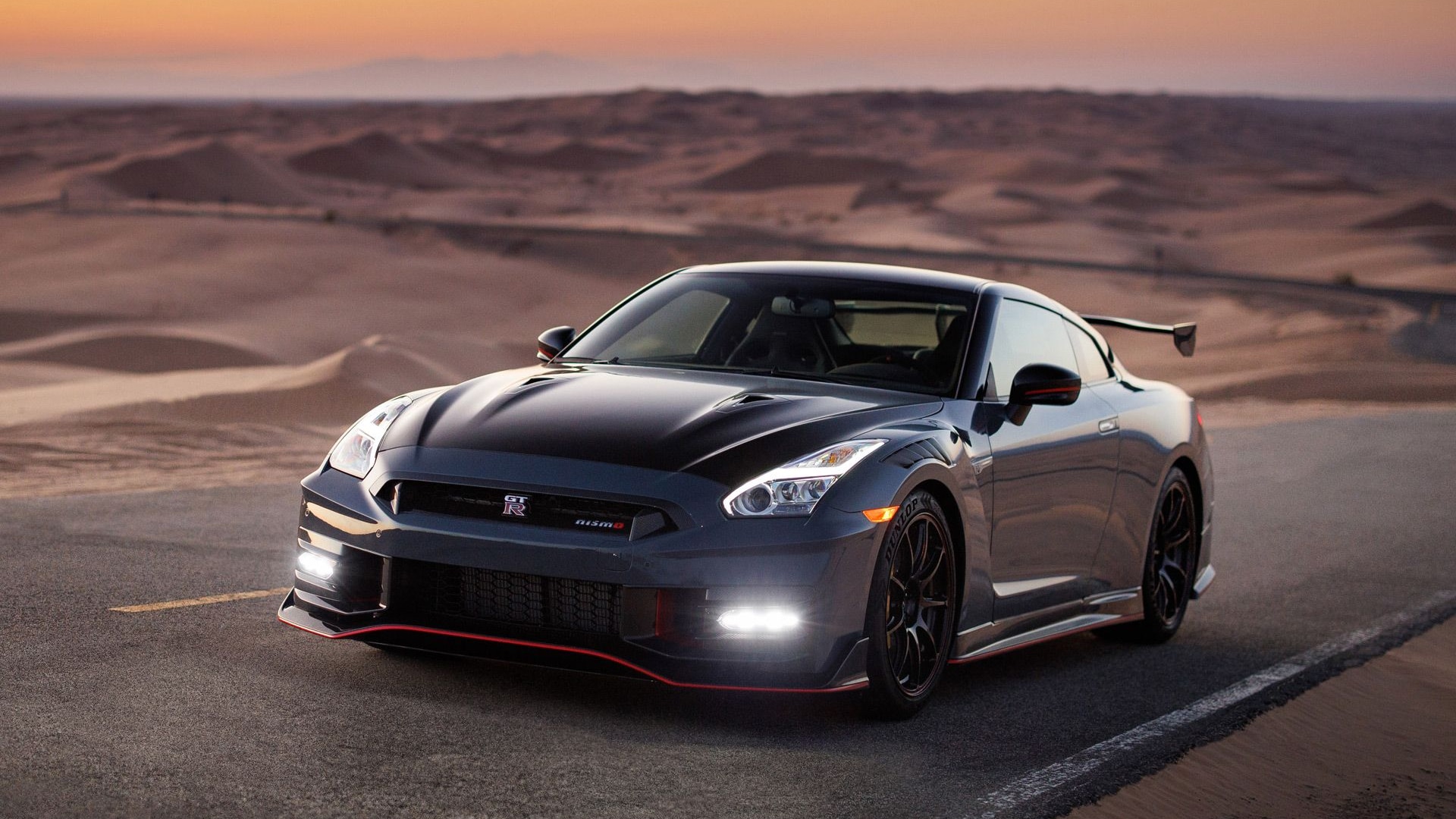It’s a 37-degree January afternoon in Michigan at General Motors’ Milford Proving Ground. The “black lake” sea of asphalt test area wears a sheen of moisture on a day that threatens rain but doesn’t deliver, and yet the 2024 Chevrolet Corvette E-Ray spins its front and rear tires just for a beat before it hooks up and rockets forward.
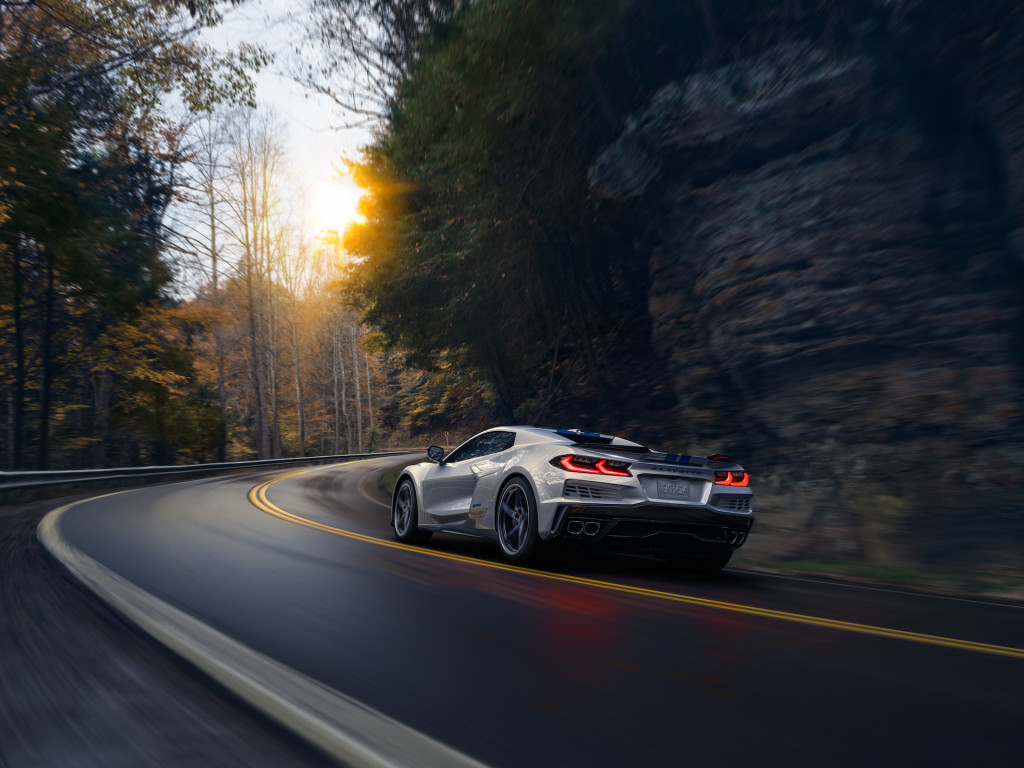
2024 Chevrolet Corvette E-Ray
Exhilarating acceleration
The shock of a hard launch is my first impression from the passenger seat while Corvette Chassis Development Engineer Bill Wise takes the wheel. The greatest leap the mid-engine C8 Corvette took versus the front-engine C7 was its ability to transfer its power efficiently to the pavement; moving the engine over the rear axle greatly improved traction. Now, the 2024 Corvette E-Ray bests them both by adding power at the front axle.
The first-ever hybrid Corvette and the first with all-wheel drive, the Corvette E-Ray enhances the Stingray’s 495-hp 6.2-liter V-8 with a front-axle-mounted electric motor that spins out 160 hp and 125 lb-ft of torque. The duo combines to make 655 hp. While that’s 15 hp shy of the 2023 Corvette Z06, the E-Ray sprints from 0-60 mph 0.4 second quicker at just 2.5 seconds. It also covers the quarter mile in 10.5 seconds, a tenth quicker than the Z06.
An 8.16:1 torque multiplication on the front motor gives it about 1,020 lb-ft of torque at takeoff to help the power arrive earlier than it does in the Stingray. A 1.9-kwh battery pack is mounted in the center tunnel and weighs a little more than 100 pounds. Chevy uses a little more than half of that to add and accept power quickly, or to drive the car on electricity alone.
“Our mental model was this is all about performance. We don’t want to try to get long EV range. We want to enhance the capability of the car,” noted Tadge Juechter, the Corvette’s executive chief engineer in a meeting with Motor Authority after the ride-along.
The battery and hybrid system’s inverter take up all usable space in the center tunnel, so a larger battery is highly unlikely. The battery consists of four modules of 20 pouch cells, and according to Josh Holder, the Corvette’s chief engineer, the C8 was designed to fit this battery from the start.
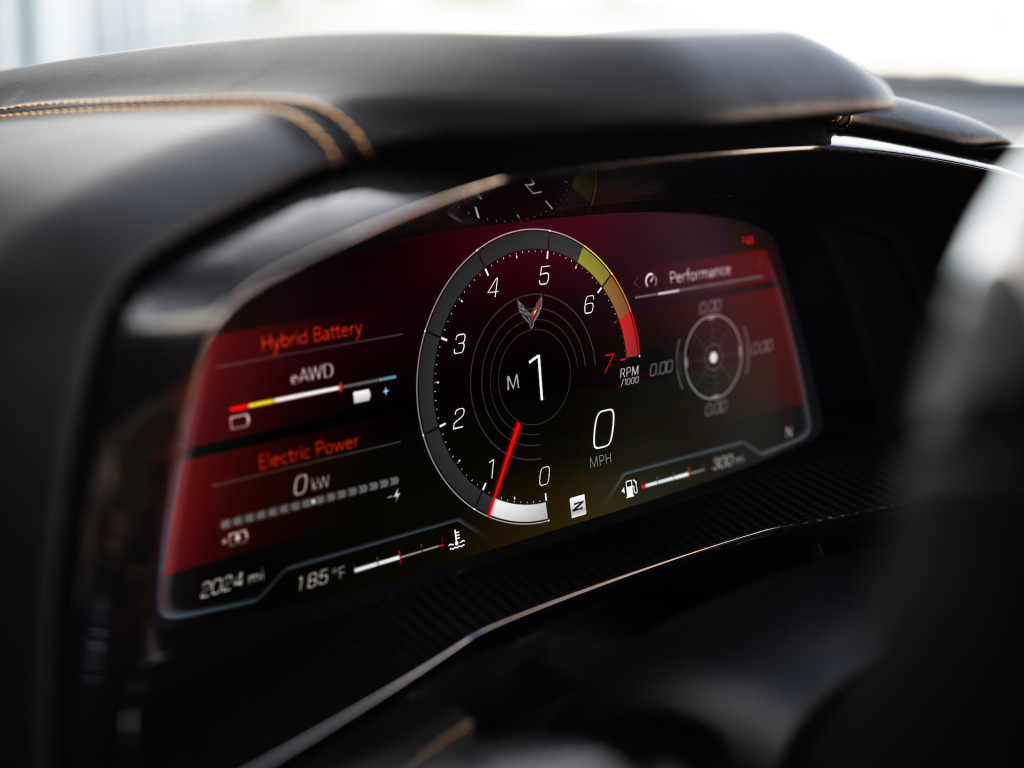
2024 Chevrolet Corvette E-Ray
Wise puts the car through another exercise that involves a rolling “launch” from about 45 mph. This time the car has to go from running on electricity to starting the engine. From the passenger seat, the transition is thrilling. The 6.2-liter V-8 fires up with its characteristic bark and quickly gives the car a shot of adrenaline. Again, I can’t feel it through the throttle, but my chat with engineers revealed it’s a two- to three-second transition as the transmission has to pick the appropriate gear, the exhaust catalysts have to fire, and the engine has to stabilize and match what the driver is asking it to do. Red, yellow, and green graphics in the instrument cluster show some of the process, including the final notification when the engine is synchronized.
Chevy gives the E-Ray two electric driving modes: Stealth and Shuttle, and both can be chosen by putting a foot on the brake and turning the center console-mounted controller dial before startup. Both also trigger an artificial exterior sound akin to a flying saucer hanging ominously overhead to warn pedestrians of the car’s presence.
Shuttle mode allows the car to drive up to 15 mph and never turns on the engine. It’s best for moving the car around in the garage or driveway.
Stealth mode can drive the car at speeds up to 45 mph as long as the driver never engages more than 30% throttle or starts out with more than 0.15 g of forward acceleration. Chevy engineers estimate 3-4 miles of electric driving range.
In the E-Ray’s other modes, which are shared with other Corvettes, the electric motor can add hybrid power and/or the stability of all-wheel drive when needed—well, as long as the speed stays below 150 mph. At that point, the electric motor shuts off as it approaches its rpm limit around 15,000 rpm. The electric motor can also provide an extra bit of power to keep the V-8’s Active Fuel Management cylinder shut-off system in 4-cylinder mode longer on the highway.
The E-Ray’s hybrid system requires cooling systems for the motor, battery, and power control unit. Also contributing to the added weight are front half-shafts that required tweaks to the front suspension’s geometry. The shocks move higher, and Chevy adds a tower-to-tower brace between them to retain stiffness. In total, the changes for the E-Ray add a little less than 300 pounds to the car for a total weight of 3,774 pounds for the coupe and 3,886 for the convertible.
Chevy offsets some of the weight by outfitting the car with standard carbon-ceramic brakes and replacing the lead-acid 12-volt accessory battery with a lithium-ion unit. The extra weight up front also changes the weight distribution, with roughly 41% of the weight over the front axle compared to 40% for the Corvette Stingray and 39% for the Z06.
Drift machine
After the hard and rolling launches, Wise whips the E-Ray through a coned-off autocross course and a skid pad.
He starts by putting the car in Track mode and shutting off the stability control and traction control.
Again, the power comes on strong and between that and a few flicks of the steering wheel Wise is able to induce slides in both long autocross corners and on the skidpad. The car transforms into a drift machine, spinning its Michelin Pilot Sport all-season tires (stickier summer performance 4S are also available, as are a set of Michelin winter tires) with ease. The front motor is an X factor here, though, as it wants to pull the car out of a corner rather than allow the drifts. He maintains the drifts, though, but I won’t know how hard that is unless Chevrolet gives me the opportunity to do the same. It seems like it would be easy to get the car to drift in a corner, then use the front motor—and a little help from chassis electronics, perhaps—to power out of the turn and get back on the intended line.
Wise tells me that the battery should have enough charge to power the motor through 20 minutes of track driving—normal track driving, that is. After our run, he shows me that the drifting exercise really depleted the battery because it kept asking the front motor to intervene. There’s a solution to that, though. It’s called Charge+ mode, and it’s activated by a button on the driver’s side of the center console. It over-revs the engine to optimize the battery’s state of charge. Chevy engineers say the regen never feels like anything more than the normal resistance of a car with an automatic transmission.
I also can’t feel the braking response through the brake pedal, which can be an issue in electrified cars. The brake regen and friction braking are all fed into the braking modules, but brake feel is handled by a brake-by-wire system (with a mechanical backup) and can be adjusted by mode. Wise notes that the pedal feel won’t change when the brakes begin to fade, so the driver will have to notice that the car is taking longer to stop. That shouldn’t be much of a problem given the car has notoriously resilient carbon-ceramic brakes.
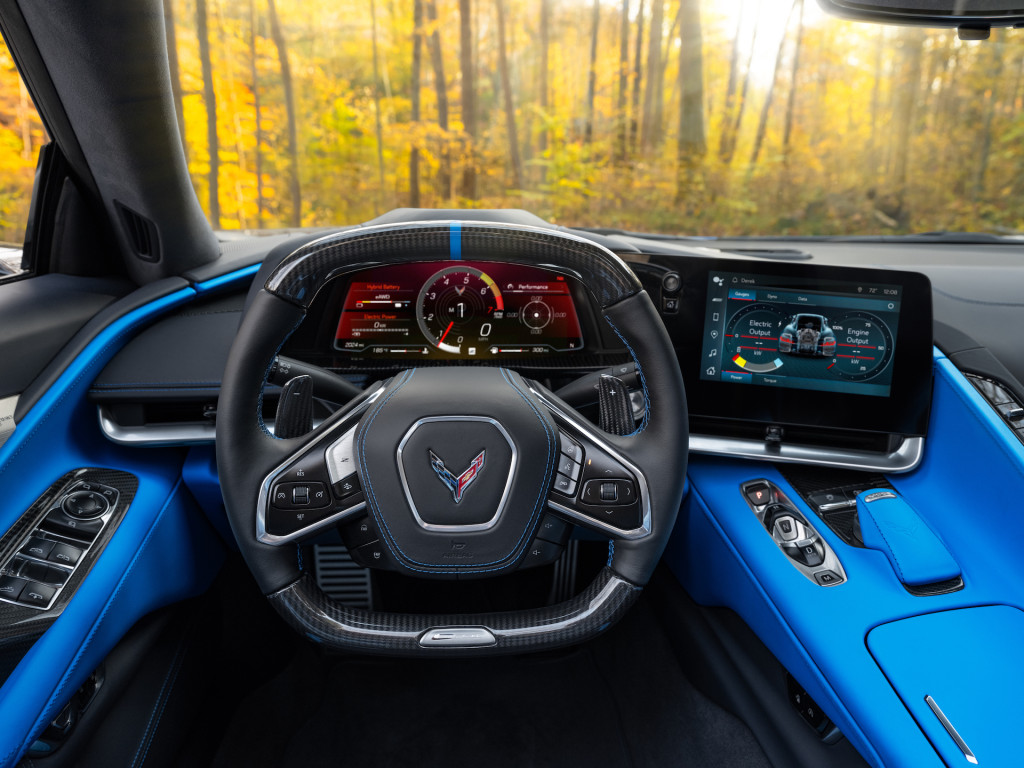
2024 Chevrolet Corvette E-Ray
Finally, Wise runs me through the E-Ray Performance App that’s added to the infotainment system. It has digital gauges that show the engine and electric motor output, a dyno screen that shows a graph of power and torque across chosen time intervals, and a data screen that shows the performance and efficiency of the electrical system. Drivers can also check out readouts for the drive motor rpm, high-voltage battery temperature, and drive unit oil temperature. A couple of widgets can also be added to the digital instrument cluster that show state of battery charge and power flow.
Due for release later this year, the Corvette E-Ray will start at $104,295 in coupe form and $111,295 for the convertible. The prices are close to the $106,695 (coupe) and $114,195 (convertible) of the Z06 coupe, though that car is also saddled with a $2,600 gas-guzzler tax that the E-Ray avoids.
Still, the hybrid system’s big price premium affected the car’s packaging. Chevy could have fit the hybrid system in the Stingray’s body, but instead chose the Z06’s wide body, which is 3.6 inches wider and uses wider 275/30/R20 front and 345/25R21 rear tires.
“All this content is fairly expensive, so we had to move the price up,” Juechter explained. “You kinda have to go with widebody. It’s obvious it’s worth extra money.”
“We could do it on the narrow body and do sort of a fuel economy special, but that’s not why people buy Corvettes,” Juechter quipped.
The Z06 and E-Ray are quite different, though. “We’ve got similar price points, and similar horsepowers, but a very different mission. It (the E-Ray) is more of a grand touring, GT car, something you could drive all day long,” Juechter said. “The Z06, if you use it as it’s intended on the street, you’re going to lose your license.”
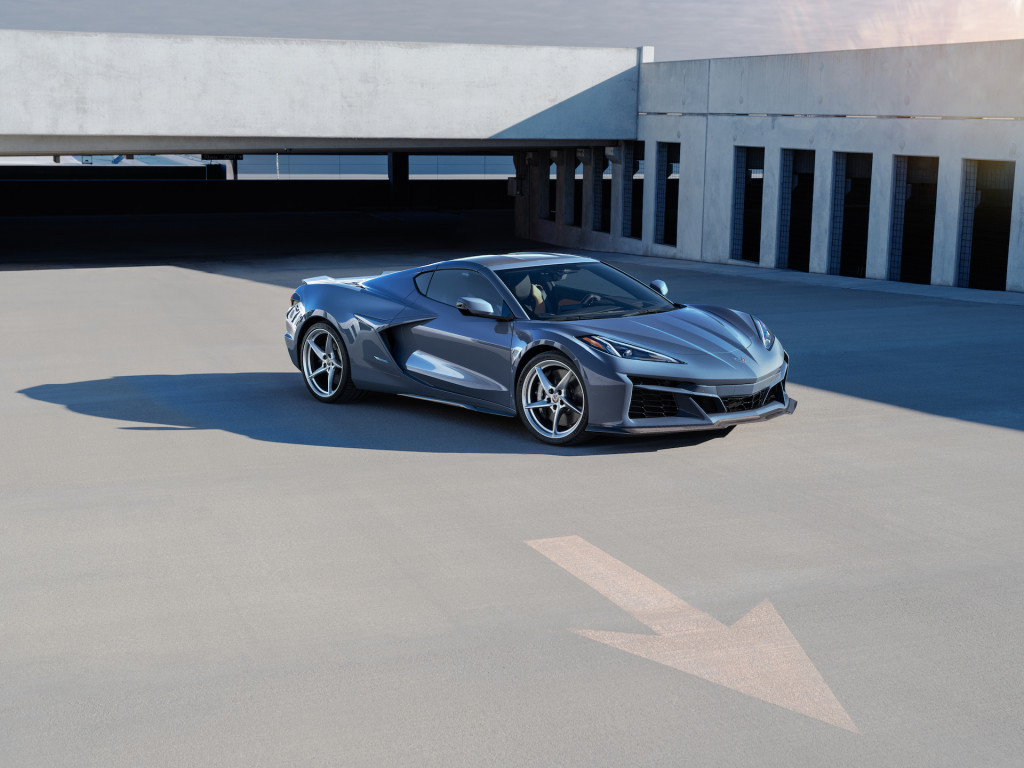
2024 Chevrolet Corvette E-Ray
To visually differentiate the E-Ray from the Z06, the hybrid has body-color trim, its own twisted five-spoke wheels, carbon-flash badges, and an exclusive option Electric Blue full-length stripe package.
Fuel economy ratings aren’t yet available, but Chevy engineers said they’re aiming for Stingray fuel economy numbers, which come in at 16 mpg city, 24 highway, 19 combined. Chevy engineers estimated the E-Ray should be better in the city due to the hybrid assist but worse on the highway due to extra drag from the wider body, bigger tires, and greater cooling requirements.
The new Corvette E-Ray, as well as all other Corvettes, will also come with a few safety features that haven’t been available thus far on the C8. They include forward-collision warnings (without automatic emergency braking), active lane control, and a following distance indicator. The E-Ray will also introduce to the Corvette lineup Riptide Blue, Seawolf Gray, and Cacti exterior colors, as well as an Artemis interior color that is a gray with a touch of green.
In comfort and cornering prowess, the 2024 Chevrolet Corvette E-Ray sits in a middle ground between the Stingray with the Z51 Performance Package, and the Z06. Chevy engineers say they stiffened the suspension versus the Z51 Stingray, including the tuning or the standard magnetic dampers, but it’s not as firm as the Z06.
We’ll wait patiently to render our opinion until we get behind the wheel later this year, but a first ride showed that the performance is likely there, and Chevy’s own performance numbers back up the claim. The E-Ray should essentially deliver Z06 power in a more civilized package, without as much of a cacophony from its engine or as hard of a ride from its suspension.
We look forward to reporting on how it feels from the driver’s seat.
Chevrolet paid for travel so Motor Authority could bring you this firsthand report.
